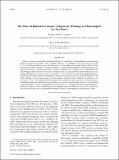The Effect of Diurnal Sea Surface Temperature Warming on Climatological Air–Sea Fluxes
Author(s)
Clayson, Carol Anne; Bogdanoff, Alec Setnor
DownloadClayson-2013-The Effect of diurna.pdf (4.359Mb)
PUBLISHER_POLICY
Publisher Policy
Article is made available in accordance with the publisher's policy and may be subject to US copyright law. Please refer to the publisher's site for terms of use.
Terms of use
Metadata
Show full item recordAbstract
Diurnal sea surface warming affects the fluxes of latent heat, sensible heat, and upwelling longwave radiation. Diurnal warming most typically reaches maximum values of 3°C, although very localized events may reach 7°–8°C. An analysis of multiple years of diurnal warming over the global ice-free oceans indicates that heat fluxes determined by using the predawn sea surface temperature can differ by more than 100% in localized regions over those in which the sea surface temperature is allowed to fluctuate on a diurnal basis. A comparison of flux climatologies produced by these two analyses demonstrates that significant portions of the tropical oceans experience differences on a yearly average of up to 10 W m[superscript −2]. Regions with the highest climatological differences include the Arabian Sea and the Bay of Bengal, as well as the equatorial western and eastern Pacific Ocean, the Gulf of Mexico, and the western coasts of Central America and North Africa. Globally the difference is on average 4.45 W m[superscript −2]. The difference in the evaporation rate globally is on the order of 4% of the total ocean–atmosphere evaporation. Although the instantaneous, year-to-year, and seasonal fluctuations in various locations can be substantial, the global average differs by less than 0.1 W m[superscript −2] throughout the entire 10-yr time period. A global heat budget that uses atmospheric datasets containing diurnal variability but a sea surface temperature that has removed this signal may be underestimating the flux to the atmosphere by a fairly constant value.
Date issued
2013-04Department
Massachusetts Institute of Technology. Department of Earth, Atmospheric, and Planetary Sciences; Woods Hole Oceanographic InstitutionJournal
Journal of Climate
Publisher
American Meteorological Society
Citation
Clayson, Carol Anne, and Alec S. Bogdanoff. “The Effect of Diurnal Sea Surface Temperature Warming on Climatological Air–Sea Fluxes.” Journal of Climate 26, no. 8 (April 2013): 2546-2556. © 2013 American Meteorological Society
Version: Final published version
ISSN
0894-8755
1520-0442